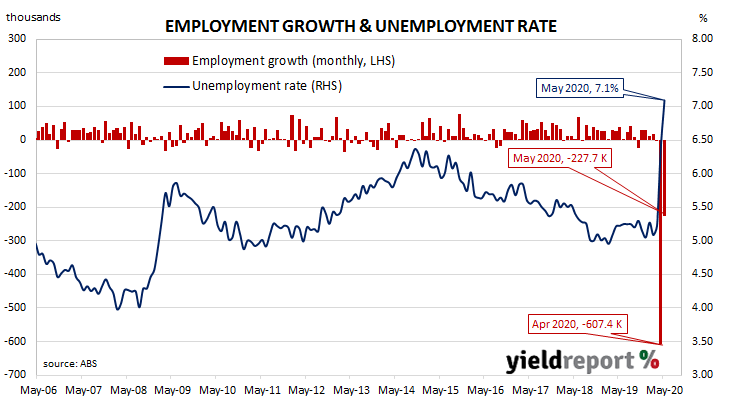Summary: Jobless rate rises above 7%; April job losses revised up; unemployment more than expected but less than in April; participation rate continued falling as former workers give up; work hours fall less than employment; underemployment rate eases.
Australia’s period of falling unemployment came to an end in early 2019 when the jobless rate hit a low of 4.9%. It then averaged around 5.2% through to March 2020, bouncing around in a range from 5.1% to 5.3%. Recent readings of leading indicators such as ANZ’s Job Ads survey and NAB’s capacity utilisation estimate suggested the unemployment rate would rise and it has. They also leave some room for further rises towards Treasury’s recent forecast of an 8% unemployment rate by the end of June.
The latest Labour force figures have now been released and they indicate the number of people employed in Australia fell by considerably more than economists had expected. The report showed the total number of people who held a job according to ABS definitions fell by 227,700 in May, a smaller fall than in April when 607,400 people lost their jobs after it was revised up from 594,300. The unemployment rate rose from April’s revised figure of 6.4% to 7.1%.
NAB Head of FX Strategy (FICC division) Ray Attrill said the figures “were in most respects worse than expected. Employment fell a further 228,000, far worse than market expectations for a 79,000 fall. This means that over the past two months, 835,000 people have lost their jobs.” Market expectations prior to the report’s release were for about 80,000 positions to be lost and for the unemployment rate to rise to 7.0%. Domestic Treasury bond yields fell moderately at the long end of the curve, falling a few basis points more than their US counterparts had in overnight trading. By the end of the day, the 90-day bank bill rate remained unchanged at 0.10%, the 3-year ACGB yield had slipped 1bp to 0.27% while 10-year and 20-year yields had each declined by 4bps to 0.90% and 1.52% respectively.
Market expectations prior to the report’s release were for about 80,000 positions to be lost and for the unemployment rate to rise to 7.0%. Domestic Treasury bond yields fell moderately at the long end of the curve, falling a few basis points more than their US counterparts had in overnight trading. By the end of the day, the 90-day bank bill rate remained unchanged at 0.10%, the 3-year ACGB yield had slipped 1bp to 0.27% while 10-year and 20-year yields had each declined by 4bps to 0.90% and 1.52% respectively.
Prices of cash futures contracts moved to reflect a slight softening of rate-cut expectations. By the end of the day, July contracts implied a rate cut down to zero as a 57% chance, down from the previous day’s 59%. August contracts implied a 51% chance of such a move in that month, unchanged. Contract prices of months in the remainder of 2020 and through to mid-2021 implied probabilities ranging between 41% and 53%.

